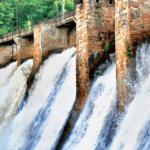One of the most obvious and ubiquitous problems in the Kathmandu valley is improper waste management. Most of the households do not segregate their waste, waste collection is still in its rudimentary phase with no protection mechanism for waste pickers, only a handful of recyclers operating in the valley, and piles of garbage seem to be scattered in all major streets and rivers. The unsystematic, unscientific, and ineffective current waste infrastructure has led to half of all waste being dumped in Sisdol landfill and only a small percent of it is recycled or composted.
The valley generates a whopping 1200 metric tonnes of solid waste in a day[1] which is almost equal to 11.5 blue whales. Sadly, this number is only going to go up. The Kathmandu valley is one of the fastest-growing regions with an annual growth rate of 6.5%[2]. Considering this as well as the global average waste generation rate per person in cities i.e. 0.77-0.8 kgs/ day, the valley would have to manage around 2000 metric tonnes of waste in 2025. To add to that is the fact that the current landfill site at Sisdol has already reached its capacity.
The valley’s waste problem is no longer an issue to be avoided and forgotten, it requires urgent and concrete actions.
The question, however, is where to start from? At a time when everything seems like a problem, the answer to this question is not straightforward. However, we can always look for cases similar to Kathmandu and take inspiration from the same.
Recently, I stumbled upon a compendium of good practices of urban solid waste management in Indian cities. As I reflect upon the report, I have three major steps that the valley can take to move towards a circular and effective waste infrastructure.
Decentralized Waste System
Pune, the second largest city of Maharashtra in India, has been widely lauded for its decentralized waste management system and has also received an ISO 9001 certification for the same. However, back in 2005, Pune also suffered issues similar to what we are facing in the valley. Garbage overflowed from community containers and the Pune Municipal Corporation (PMC) collected mixed waste from the communities. Waste segregation was being carried out to some extent by waste pickers who were mostly ignored. All of this changed when a registered trade union of waste pickers advocated with the PMC to recognize the contribution of waste pickers. Finally, the PMC launched a pilot program for door-to-door collection in partnership with the union of waste pickers. The union later became SWaCH, a cooperative of self-employed waste pickers to provide front-end waste management services. While SWaCH collected waste from households and commercial establishments, the PMC played the role of facilitator providing necessary equipment and infrastructure. Further, SWaCH was also given the authority to enter into contracts with housing societies, institutions for waste collection and on-site processing. Currently, the city recycles 80-85% of its waste and that has been possible because of the potent decentralized waste system in place.
Even though the importance and effectiveness of Public Private Partnership has been emphasized in the Solid Waste Management Policy (1996), it has still not come to fruition. Pune presents actionable steps as to how this can be done.
Consistent Dialogue for a Sustainable Model
The partnership between the PMC and SWaCH was not an overnight thing. It happened due to consistent dialogues and a genuine interest to take the partnership forth. It was in the early 1990s when the waste pickers formed an alliance and only in 2005, the PMC went ahead with the collaboration. Also, the association started with a pilot project of two years covering a certain area in the city. Once the project was evaluated, it was scaled up to cover the whole city. While we might be overwhelmed as to where to start, the case of Pune teaches us that it is necessary to start small and keep the momentum going. Considering the efficient informal waste system in place, it is always possible to bring them to the mainstream if we start dialogues as soon as possible.
Kathmandu has a population of 10000-15000 waste scavengers as of 2018. Pune offers a really good example of how we can strengthen the structure already in place and reap benefits out of it.
A Master Plan
All effective implementation depends upon a good master plan and vision. While the KMC has a set of rules, acts and policies for waste management, the implementation is far from effective. The city Ahmedabad offers a good example in regard to this. Back in 2009, Ahmedabad was lagging behind in its goal of being a clean city despite huge investments in the SWM sector. However, it turned the tides by first signing the International Partnership for Expanding Waste Management Services of Local Authorities (IPLA) declaration for Moving Towards Zero Waste. That was just a start, what followed was more important. Ahmedabad undertook a visioning exercise to lay out strategies to become a Resource Efficient and Zero Waste City by 2031. The plan consisted of 10 focal areas and 34 strategic actions to introduce and implement policies and strategies, and raise awareness among private, business and industrial communities. A master plan was drafted to include a comprehensive analysis of the existing situation along with clear recommendations, budget, alternate scenarios, timelines, institutional arrangement and human resource requirements. With a similar master plan, Kathmandu could also bring out actions that address pressing issues in the SWM sector.
The waste problem in Kathmandu valley needs immediate actions. And maybe the first steps could be to draft a detailed master plan, initiate collaboration with the powerful informal waste system and prioritize decentralized waste systems.
[1] Ojha, Anup. ‘How Kathmandu’s waste management emerged as a perennial problem’, The Kathmandu Post, 16 April 2021. Retrieved from: https://kathmandupost.com/valley/2021/04/16/how-kathmandu-s-waste-management-emerged-as-a-perennial-problem
[2] Timsina, Netra Prasad, Anushiya Shrestha, Dilli Prasad Poudel, and Rachana Upadhyaya. “Trend of urban growth in Nepal with a focus in Kathmandu Valley: A review of processes and drivers of change.” (2020).





